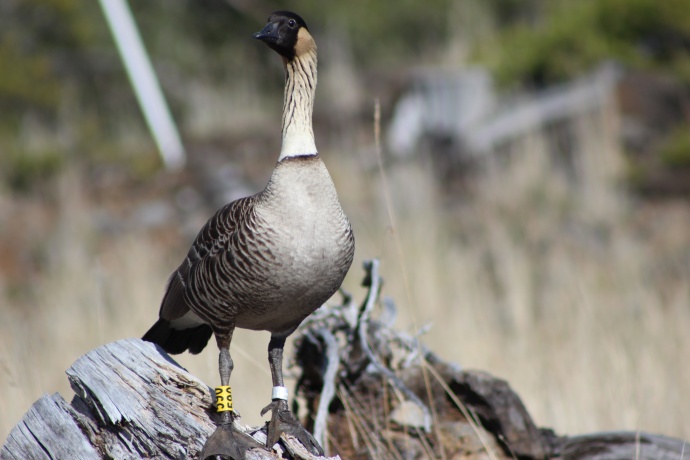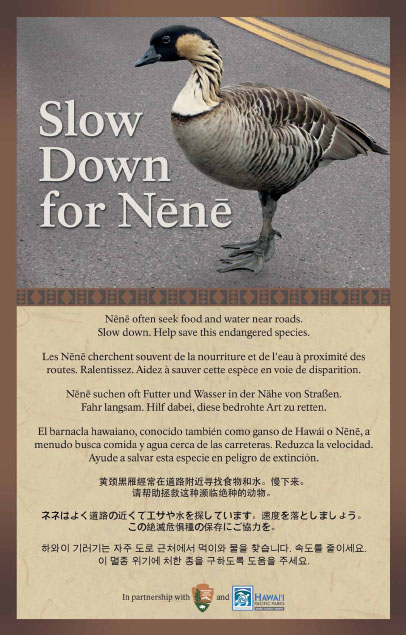Two Endangered Nēnē Killed by Speeding Cars at Haleakalā

A male nēnē stands guard as the female incubates eggs. Male nēnē are mobile and can be on roads while females incubate eggs. Photo courtesy Haleakalā National Park.
By Wendy Osher
Officials at Haleakalā National Park issued another reminder to motorists to slow down, saying two female nēnē were killed recently by speeding motorists on Crater Road.
One fatality occurred outside the park near mile post 9 on Tuesday, Nov. 12; and the other occurred in the down-bound lane of the Park’s highway at the Hosmer Grove intersection on Friday, Nov. 15.
Park officials say the carcass of the adult nēnē from the latter incident was in extremely poor condition and was likely hit by a vehicle driving through the Park.
“This is a truly worrisome start to the nēnē breeding season,” said park superintendent Natalie Gates in a media statement.
“We didn’t just lose two birds; we lost several potential generations of an endangered species. Driving slowly along the entire length of Crater Road is the only truly controllable thing humans can do, on a daily basis, to help this species,” she said.
According to the latest estimates released by the NPS, there are less than 300 nēnē left in the park. Park officials say the nēnē is endangered due to “habitat loss and non-native predators, such as cats and mongoose, that eat eggs and prey on birds.”

The park is working with the visitor industry to get the word out to all visitors about slowing down and driving carefully. Image courtesy Haleakalā National Park.
The news comes as the park put out an advisory reminding motorists about the nēnē nesting and breeding season last week, and a new educational effort that includes signage and posters printed in six different languages throughout the park, so that visitors can understand the plight of the nēnē.
The posters are placed in the two summit visitor centers and at the Summit Entrance Station. Park staff are also working with the visitor industry to get the word out to those planning a trip to Haleakalā.
“The road bisects the nēnē’s breeding habitat,” said park wildlife biologist Cathleen Bailey in the announcement. “Nēnē literally cross roads to ‘get to the other side.’”
Polly Angelakis, chief of interpretation and education at Haleakalā National Park said motorists should be especially careful around shoulder areas of the road where the nēnē are known to forage in short grass, and in the middle of the road where nēnē are drawn to the pools of water that collect during wet weather.

A female nene incubates eggs. This and one other nene are nesting alongside the park road. Photo courtesy Haleakalā National Park.
Park officials say they are working to make roadsides less attractive to nēnē by removing short grass and filling in holes. They have also placed traffic cones, caution signs, and other traffic calming devices in the park to remind drivers to slow down.
The birds are especially active during breeding season and more likely to be seen by visitors during this time, officials said.
“Many motorists are not used to the steepness of the road and how fast a car can suddenly pick up speed,” said Angelakis. “Visitors should use low gear when driving downhill to hold back their vehicles and save wear and tear on their brakes. Using low gear will make their own journey safer and help save this bird and other wildlife.”
Last year, park officials said that on average, there has been one nēnē road fatality per year during the nesting season.
“Nēnē have been around for thousands of years; cars have only been here for 100. The birds just aren’t used to cars. Please slow down and drive carefully, especially in low light conditions,” said Angelakis.









